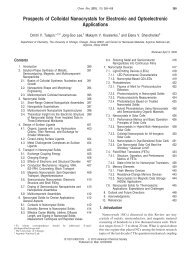Data Warehousing and Data Mining Announcements (Tue. Dec. 3 ...
Data Warehousing and Data Mining Announcements (Tue. Dec. 3 ...
Data Warehousing and Data Mining Announcements (Tue. Dec. 3 ...
You also want an ePaper? Increase the reach of your titles
YUMPU automatically turns print PDFs into web optimized ePapers that Google loves.
CUBE operator<br />
13<br />
Aggregation lattice<br />
14<br />
Sale (CID, PID, SID, qty)<br />
Proposed SQL extension:<br />
SELECT SUM(qty) FROM Sale<br />
GROUP BY CUBE CID, PID, SID;<br />
Output contains:<br />
Normal groups produced by GROUP BY<br />
• (c1, p1, s1, sum), (c1, p2, s3, sum), etc.<br />
Groups with one or more ALL’s<br />
• (ALL, p1, s1, sum), (c2, ALL, ALL, sum), (ALL, ALL, ALL, sum), etc.<br />
Can you write a CUBE query using only GROUP BY’s?<br />
Gray et al., “<strong>Data</strong> Cube: A Relational Aggregation Operator<br />
Generalizing Group-By, Cross-Tab, <strong>and</strong> Sub-Total.” ICDE 1996<br />
Roll up<br />
Drill down<br />
GROUP BY<br />
CID<br />
GROUP BY<br />
CID, PID<br />
GROUP BY ∅<br />
GROUP BY<br />
PID<br />
GROUP BY<br />
CID, SID<br />
GROUP BY<br />
CID, PID, SID<br />
GROUP BY<br />
SID<br />
GROUP BY<br />
PID, SID<br />
A parent can be<br />
computed from any child<br />
Materialized views<br />
Computing GROUP BY <strong>and</strong> CUBE aggregates is<br />
expensive<br />
OLAP queries perform these operations over <strong>and</strong><br />
over again<br />
Idea: precompute <strong>and</strong> store the aggregates as<br />
materialized views<br />
Maintained automatically as base data changes<br />
No. 1 user-requested feature in PostgreSQL!<br />
15<br />
Selecting views to materialize<br />
Factors in deciding what to materialize<br />
What is its storage cost?<br />
What is its update cost?<br />
Which queries can benefit from it?<br />
How much can a query benefit from it?<br />
Example<br />
GROUP BY ∅ is small, but not useful to most queries<br />
GROUP BY CID, PID, SID is useful to any query, but too large<br />
to be beneficial<br />
Harinarayan et al., “Implementing <strong>Data</strong> Cubes Efficiently.” SIGMOD<br />
1996<br />
16<br />
Other OLAP extensions<br />
Besides extended grouping capabilities (e.g., CUBE),<br />
window operations have also been added to SQL<br />
A “window” specifies an ordered list of rows related<br />
to the “current row”<br />
A window function computes a value from this list<br />
<strong>and</strong> the “current row”<br />
St<strong>and</strong>ard aggregates: COUNT, SUM, AVG, MIN, MAX<br />
New functions: RANK, PERCENT_RANK, LAG, LEAD, …<br />
17<br />
RANK window function example<br />
sid | pid | cid | qty<br />
------------+------------+------------+-----<br />
Durham | beer | Alice | 10<br />
Durham | beer | Bob | 2<br />
Durham | chips | Bob | 3<br />
Durham | diaper | Alice | 5<br />
Raleigh | beer | Alice | 2<br />
Raleigh | diaper | Bob | 100<br />
GROUP BY<br />
sid | pid | cid | qty<br />
------------+------------+------------+-----<br />
Durham | beer | Alice | 10<br />
| | Bob | 2<br />
Durham | chips | Bob | 3<br />
Durham | diaper | Alice | 5<br />
Raleigh | beer | Alice | 2<br />
Raleigh | diaper | Bob | 100<br />
E.g., for the following “row,”<br />
Durham | beer | Alice | 10<br />
| | Bob | 2<br />
SELECT SID, PID, SUM(qty),<br />
RANK() OVER w<br />
FROM Sale GROUP BY SID, PID<br />
WINDOW w AS<br />
(PARTITION BY SID<br />
ORDER BY SUM(qty) DESC);<br />
Apply WINDOW after processing<br />
FROM, WHERE, GROUP BY, HAVING<br />
PARTITION defines the related<br />
set <strong>and</strong> ORDER BY orders it<br />
the related list is:<br />
Durham | beer | Alice | 10<br />
| | Bob | 2<br />
Durham | diaper | Alice | 5<br />
Durham | chips | Bob | 3<br />
18<br />
3
















